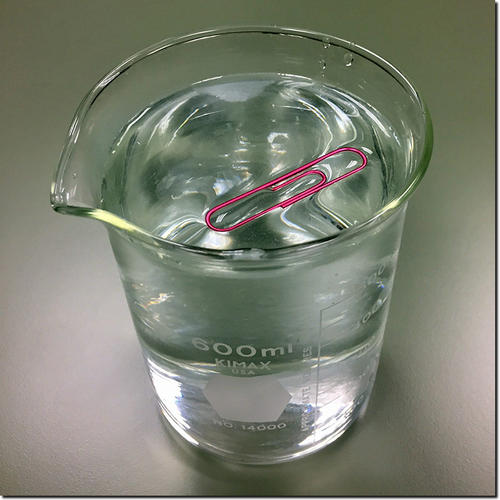What forces make bubbles and droplets round?
Figure 3.29 makes it very clear that both soap bubbles and water droplets tend to be round. But why does this happen, and why is it true for water droplets in space but not for water droplets on Earth?
The forces that hold soap bubbles and liquid droplets together are generally referred to as forces of surface tension. Surface tension is created by the many small forces that attract individual molecules to one another. You are familiar with surface tension on the top of any water surface, such as in a glass of water or a pond or lake. For example, surface tension is what allows a paperclip to float in a glass of water, even though the paperclip is denser than the water (Figure 1). You can feel surface tension for yourself by pressing your finger gently on the water surface; you’ll notice that the water surface can remain unbroken until you press harder.

When you make a soap bubble or a small liquid droplet, the fact that the forces of surface tension act equally between adjacent molecules on the surface means that they hold the bubbles or droplets together with an inward pull that is equal in all directions. They therefore tend to become spherical, just as Figure 3.29 shows for the soap bubbles on Earth and the water droplets in space.
So why are water droplets on Earth teardrop shaped instead of spherical? The answer is the effects of gravity. In space, the fact that the droplets are weightless means they don’t feel the effects of gravity, and they therefore take on the spherical shape created by the surface tension. On Earth, their weight means they feel the downward force of gravity, and this distorts the spherical shape into a teardrop shape.
This might also make you wonder why the soap bubbles are not affected the same way on Earth, and the answer is their low density, which allows them to “float” in the air much like weightless objects float in space. This means that the upward lift of the air balances the downward force of gravity, so they don’t feel the gravity and retain a spherical shape. The same basic idea also explains why air bubbles are round in water, as you can easily witness when you pour soda water into a clear glass; you can also see this with the trapped air bubble in Figure 3.29b.